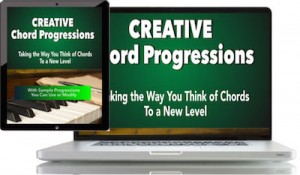It’s quite possible to use a single chord progression in every section of your song, such as you might hear in “Controlla” (Drake et al). But if you do choose to use the same progression throughout a song without changing it, it’s the kind of progression that needs to sound tonally strong.
A strong progression simply means that, on its own, it strongly points to one chord as being the tonic chord. In “Controlla”, the progression is:
Am - Bm - Em / / / / / / / /
When we hear this progression, we hear the Em chord as being more important than the other two, partly by virtue of the fact that it lasts for 4 beats, while the Am and Bm last for 2. Also, once we get to hear the 3 chords, the only key that will easily accommodate all 3 chords is E minor: iv – v – i. It’s a very simple progression, but simplicity is almost never a problem when it comes to chord progressions.
And it’s more than simple… it’s strong. The key of E minor gets riveted in our musical brains early, and there’s nothing complex about it at all.
But let’s say that you’ve found an interesting progression that’s perhaps a bit more involved than the standard I-IV-V progression, perhaps something like this:
Am – F – Dm – G – Bb – F – G – Em
Listen:
How do you decide which section of your song that progression might belong?
STRONG vs FRAGILE
If you play that progression over and over, you’ll start to notice that the Am chord sounds like a tonic, and so it’s fair to say that this progression is in the key of A minor. But there is a moment within that progression that sounds as if the progression is trying to move into a new key: once we hear the Bb chord. You might hear that Bb as sounding like a new key, or perhaps you find the F that follows the Bb sounds like a new key.
In any case, Bb certainly doesn’t belong to A minor, and that’s the important point. For a moment in the middle of this progression, it sounds as though the progression is journeying away from A minor, before it comes back to A minor at the end.
And it brings us to a kind of principle that you’ll notice in most songs of the pop music genres. Two principles, in fact:
- Progressions that have “fragile” moments, like the one above, often work better in verse and bridge progressions.
- Progressions that are mainly strong, like the one in “Controlla”, work best in chorus progressions.
So here are several progressions, all of which have complex moments, moments that make the progression more suitable to verse or bridge sections:
- Am G C F Dm Em Am Em (Starts in A minor, then briefly sounds like it moves into C major).
- Am Em Am Dm Eb Bb F E7 (Starts in A minor, then briefly sounds like it moves into Bb major).
- Am Dm Em Am F C7 Dm Bb (Starts in A minor, then briefly sounds like it moves into F major).
And remember — if you want to use the same progression for an entire song, it’s best to use progressions that are shorter and tonally strong throughout, like these examples:
- Am Bm Am G
- Am Dm Em Am
- Am F Em Am
- Am C Dm Em
- Am Bm Em G
 Written by Gary Ewer. Follow Gary on Twitter
Written by Gary Ewer. Follow Gary on Twitter
 Are you looking for ways to make your progressions more creative? Tired of the same-old, same-old? This eBook, “Creative Chord Progressions“, is being offered free with your purchase of “The Essential Secrets of Songwriting” 10-eBook Bundle. Read more.
Are you looking for ways to make your progressions more creative? Tired of the same-old, same-old? This eBook, “Creative Chord Progressions“, is being offered free with your purchase of “The Essential Secrets of Songwriting” 10-eBook Bundle. Read more.











Pingback: Deciding Where in a Song a Chord Progression Belongs - The Hit Songwriting Formula | The Hit Songwriting Formula